- Clone
- 1G9 (See other available formats)
- Regulatory Status
- RUO
- Other Names
- VSIG9
- Isotype
- Mouse IgG1, κ
- Ave. Rating
- Submit a Review
- Product Citations
- publications
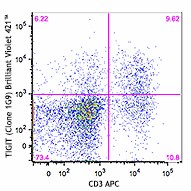
-

C57BL/6 mouse splenocytes were stimulated with anti-CD3 and anti-CD28 antibodies for 24 hours then stained with CD3 APC and TIGIT (clone 1G9) Brilliant Violet 421™ (top) or mouse IgG1, κ Brilliant Violet 421™ isotype control (bottom). -

| Cat # | Size | Price | Quantity Check Availability | Save | ||
|---|---|---|---|---|---|---|
| 142111 | 50 µg | £166 | ||||
T cell immunoreceptor with Ig and ITIM domains (TIGIT), also known as V-set and transmembrane domain-containing protein 3 (Vstm3), is a 26 kD, type I transmembrane protein and member of the CD28 family. TIGIT is expressed on activated T cells, follicular T helper, memory, and regulatory T cells as well as on NK cells. Its binding partners include CD155 (PVR) and CD112 (PVRL2). TIGIT is a negative regulator of NK and T cell activation. Engagement of TIGIT by dendritic cells results in their differentiation into a tolerogenic phenotype, with an increased secretion of IL-10 and a diminished production of IL-12. Mice deficient for TIGIT are more susceptible to autoimmune disease.
Product DetailsProduct Details
- Verified Reactivity
- Mouse
- Antibody Type
- Monoclonal
- Host Species
- Mouse
- Formulation
- Phosphate-buffered solution, pH 7.2, containing 0.09% sodium azide and BSA (origin USA).
- Preparation
- The antibody was purified by affinity chromatography and conjugated with Brilliant Violet 421™ under optimal conditions.
- Concentration
- 0.2 mg/ml
- Storage & Handling
- The antibody solution should be stored undiluted between 2°C and 8°C, and protected from prolonged exposure to light. Do not freeze.
- Application
-
FC - Quality tested
- Recommended Usage
-
Each lot of this antibody is quality control tested by immunofluorescent staining with flow cytometric analysis. For flow cytometric staining, the suggested use of this reagent is ≤0.25 µg per million cells in 100 µl volume. It is recommended that the reagent be titrated for optimal performance for each application.
Brilliant Violet 421™ excites at 405 nm and emits at 421 nm. The standard bandpass filter 450/50 nm is recommended for detection. Brilliant Violet 421™ is a trademark of Sirigen Group Ltd.
Learn more about Brilliant Violet™.
This product is subject to proprietary rights of Sirigen Inc. and is made and sold under license from Sirigen Inc. The purchase of this product conveys to the buyer a non-transferable right to use the purchased product for research purposes only. This product may not be resold or incorporated in any manner into another product for resale. Any use for therapeutics or diagnostics is strictly prohibited. This product is covered by U.S. Patent(s), pending patent applications and foreign equivalents. - Excitation Laser
-
Violet Laser (405 nm)
-
Application References
(PubMed link indicates BioLegend citation) -
- Joller N, et al. 2010. J. Immunol. 186:1338.
- Product Citations
-
- RRID
-
AB_2687311 (BioLegend Cat. No. 142111)
Antigen Details
- Structure
- Type I transmembrane protein, 26 kD, member of the CD28 family. Contains 1 Ig-like domain and 1 cytoplasmic ITIM motif.
- Distribution
-
Activated T cells, follicular T helper cells, NK, memory T cells, Tregs.
- Function
- Negative regulator of T cell activation and proliferation. Induction of tolerogenic dendritic cells.
- Ligand/Receptor
- CD155 (PVR) and CD112 (PVRL2).
- Cell Type
- Dendritic cells, NK cells, T cells, Tregs
- Biology Area
- Immunology, Inhibitory Molecules
- Molecular Family
- Adhesion Molecules, Immune Checkpoint Receptors
- Antigen References
-
1. Levin SD, et al. 2011. Eur. J. Immunol. 41:902.
2. Yu X, et al. 2009. Nat. Immunol. 10:48.
3. Stanietsky N, et al. 2009. P. Natl. Acad. Sci. USA 106:17858. - Gene ID
- 100043314 View all products for this Gene ID
- UniProt
- View information about TIGIT on UniProt.org
Related Pages & Pathways
Pages
Related FAQs
- What is the F/P ratio range of our BV421™ format antibody reagents?
-
It is lot-specific. On average it ranges between 2-4.
Other Formats
View All TIGIT Reagents Request Custom Conjugation| Description | Clone | Applications |
|---|---|---|
| Purified anti-mouse TIGIT (Vstm3) | 1G9 | FC |
| PE anti-mouse TIGIT (Vstm3) | 1G9 | FC |
| APC anti-mouse TIGIT (Vstm3) | 1G9 | FC |
| PE/Cyanine7 anti-mouse TIGIT (Vstm3) | 1G9 | FC |
| PE/Dazzle™ 594 anti-mouse TIGIT (Vstm3) | 1G9 | FC |
| Biotin anti-mouse TIGIT (Vstm3) | 1G9 | FC |
| Brilliant Violet 421™ anti-mouse TIGIT (Vstm3) | 1G9 | FC |
| TotalSeq™-A0848 anti-mouse TIGIT (Vstm3) | 1G9 | PG |
| TotalSeq™-B0848 anti-mouse TIGIT (Vstm3) | 1G9 | PG |
| TotalSeq™-C0848 anti-mouse TIGIT (Vstm3) | 1G9 | PG |
| Brilliant Violet 605™ anti-mouse TIGIT (Vstm3) | 1G9 | FC |
| Spark Red™ 718 anti-mouse TIGIT (Vstm3) (Flexi-Fluor™) | 1G9 | FC |
Customers Also Purchased
Compare Data Across All Formats
This data display is provided for general comparisons between formats.
Your actual data may vary due to variations in samples, target cells, instruments and their settings, staining conditions, and other factors.
If you need assistance with selecting the best format contact our expert technical support team.
-
Purified anti-mouse TIGIT (Vstm3)
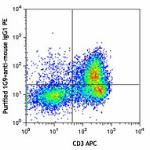
Con A-stimulated (3 days) C57BL/6 mouse splenocytes were sta... 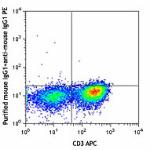
-
PE anti-mouse TIGIT (Vstm3)
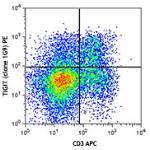
C57BL/6 mouse splenocytes were activated with anti-CD3 and a... 
-
APC anti-mouse TIGIT (Vstm3)
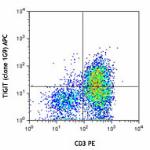
Con A-stimulated C57BL/6 mouse splenocytes (3 days) were sta... 
-
PE/Cyanine7 anti-mouse TIGIT (Vstm3)

Con-A stimulated C57BL/6 mouse splenocytes (three days) were... -
PE/Dazzle™ 594 anti-mouse TIGIT (Vstm3)
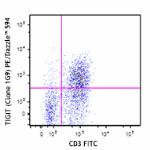
C57BL/6 Mouse splenocytes were stimulated with Con A and IL-... 
-
Biotin anti-mouse TIGIT (Vstm3)
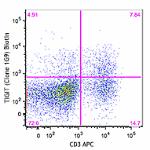
C57BL/6 mouse splenocytes were stimulated with anti-CD3 and ... 
-
Brilliant Violet 421™ anti-mouse TIGIT (Vstm3)

C57BL/6 mouse splenocytes were stimulated with anti-CD3 and ... 
-
TotalSeq™-A0848 anti-mouse TIGIT (Vstm3)
-
TotalSeq™-B0848 anti-mouse TIGIT (Vstm3)
-
TotalSeq™-C0848 anti-mouse TIGIT (Vstm3)
-
Brilliant Violet 605™ anti-mouse TIGIT (Vstm3)

ConA-stimulated C57BL/6 mouse splenocytes (3 days) were stai... -
Spark Red™ 718 anti-mouse TIGIT (Vstm3) (Flexi-Fluor™)
 Login / Register
Login / Register 










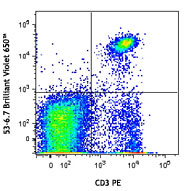

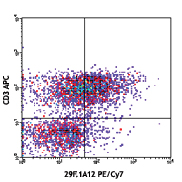
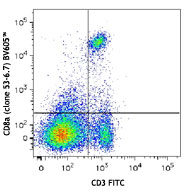



Follow Us